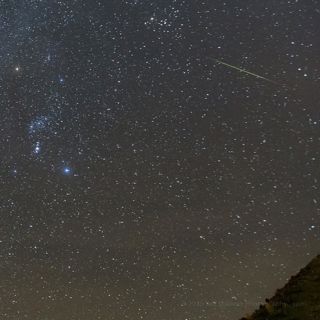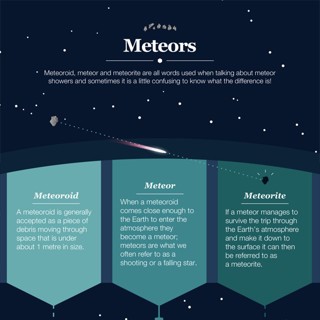
Leonid Meteor Shower 2024
- 21st Oct 2024
- Author: David Southworth (updated by Dhara Patel)
The Leonids
We’re treated to several meteor showers towards the end of the year and this week the Leonid meteor shower reaches its peak on the night of 16-17 November.
The Leonids typically produce up to 15 meteors an hour. These meteors are caused by the Earth passing through the debris left behind by comet 55P/Tempel-Tuttle. As this debris – mostly made of small dust grains – hits Earth’s atmosphere at high speed, the air in front of it is squashed together and heats up causing the debris to disintegrate in flashes of light that we call meteors.
In the past, the Leonids have produced some of the most dramatic meteor showers ever witnessed. Roughly every 33 years, a Leonids storm produces around 1000 meteors an hour, with the most dramatic in recent decades occurring in 1966. Unfortunately, this year isn't set to be one of those occasions, but should still provide a fine display.
This year the Moon will be in its waning gibbous phase, so moonlight will provide less than ideal conditions throughout the night. To increase your chances of spotting a meteor, try looking in the early hours of 17 November when the radiant of the meteor shower rises higher in the sky.

How to watch from the UK
The Leonids are named after the constellation of Leo in which the position of the radiant is located. While the meteors seemingly originate from this point in the sky they can be best seen up to 30 degrees away from Leo, stretching across large sections of the sky.
To view the Leonids from the UK, head outside in the early hours of 17 November. The darker the location the better, so find the darkest sky you can, ideally away from city lights.
The constellation of Leo will be in the east around midnight. Let your eyes adjust to the dark, and scan the whole sky. As always in the UK, clouds can be an issue, but be patient. You can also look for the Leonids on other nights around the peak date - the shower runs from 3 November to 2 December.
Meteor Infographic
Download our National Space Centre Meteor Shower Guide to make sure you are fully prepared!
Other upcoming meteor showers for 2024 include:
Geminids
Asteroid of Origin: 3200 Phaethon
Radiant: constellation Gemini
Peak Activity: 13-14 December 2024
Peak Activity Meteor Count: up to 150 meteors per hour
Ursids
Comet of Origin: 8P/Tuttle
Radiant: constellation Ursa Minor
Peak Activity: 21-22 December 2024
Peak Activity Meteor Count: up to 10 meteors per hour
Happy meteor-gazing!
Full references / credits:
(Banner image) Meteor showers. Credit: © National Space Centre
(1) Radiant of the Leonids. Credit: Stellarium
(2) Leonid meteor, 2015. Credit: Jeff Sullivan CC BY-NC-ND 2.0 DEED (https://www.flickr.com/photos/jeffreysullivan/22734925269/in/photolist-AD1rda-4J2U8p-duFAFA-5uX2wE-ivWpr-bzzXqE-4KQHPQ-4KLtse-4KLqjX-4KQFJo-4KQG2L-4KLs5Z-4KLrLX-MSpBRP-3RCgRH-aYrGG-CdTRt-3RF2yE-b4vF98-69yk9X-aYnTn-CdTFF-CdTuc-CdU6q-3RAMte-2y5ubd-aYnUh-4KLt5D-3RGs8U-CdUum-CdUEa-21BM2fd-3RBfo8-7girE8-jvWuj-aYjic-4KQHm9-rDzejM-4zydkJ-aYkhU-4DFJEC-4KQGfG-4KLrz4-du8FDL-KBFSL-cU42g-4KQHxu-7Bk1RU-4KLrmH-5iFAxX)



